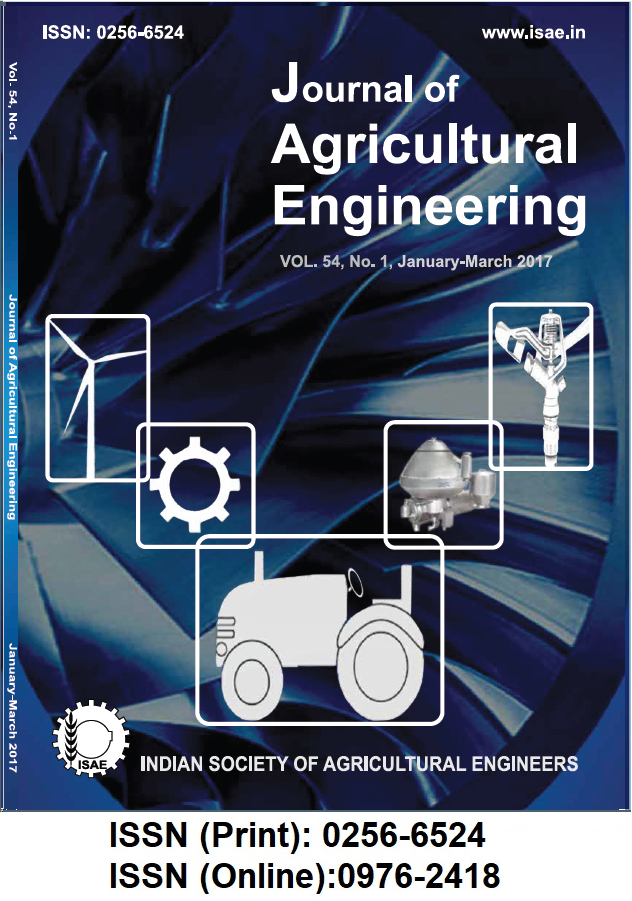Development and Performance Evaluation of Animal Drawn Garlic Digger
DOI:
https://doi.org/10.52151/jae2017541.1615Keywords:
Digger, fatigue score card, physiological parameter, digging efficiency, garlic clove, damage, draftAbstract
An animal drawn garlic digger, especially for small and marginal farms, was developed. Six types of digger blades with varied width and nose angles were evaluated for digging of garlic plants. The digger was operated at 16 % (d.b.) soil moisture content and cone index of 1350 kpa within soil profile 0-150 mm. The draft requirement of 650 mm wide blades was 30% higher than the pulling capacity of selected pair of bullocks. Blades of 550 mm of radius of curvature and 700 mm wide curved type with radius of curvature 700 mm had 86% efficiency, and required less draft with bullock fatigue score of 12. The fatigue score of blade of same width with 170° and 150° nose angle were 18 and 16, respectively. Field capacity of the digger was found to be 0.12 ha.h-1, and almost 25 times higher than that of manual digging. The average garlic damage was in the range of 3.62–5.40% for selected blades. The animal drawn garlic digger saved 75% cost and 44.8% energy as compared to the traditional method of manual digging.
References
Acharya S; Mishra M; Mayak J B. 1979. Working capacity and behavior of crossbred and non-descript indigenous bullocks under Orissa conditions. Indian J. Dairy Sci., 31, 37–42.
Anon. 2014. 19th Indian Livestock Census, All India Report. Department of Animal Husbandry, Dairying and Fisheries. Ministry of Agriculture, Government of India, 41–47.
Anon. 2015a. Agriculture Census. Department of Agriculture and Cooperation, Ministry of Agriculture, Government of India, 13-14.
Anon. 2015b. Food and Agriculture Organization (FAO). http://www.fao.org/faostat/en/#data/QC (accessed date, 02-02-2017)
Anon. 2015c. Directorate of Onion and Garlic Research (DOGR). http://www.dogr.res.in/index.php?option=comcontent&view=article&id=94&Itemid=98&lang=en (accessed date, 02-02-2017)
Anon. 2016. National Horticultural Research and Development Foundation (NHRD). http://nhrdf.org/en-us/TotalExportStatistics (accessed date, 02-02-2017)
Behera B K; Swain S; Behera D; Mohapatra A K. 2006. Studies on draftability of non-descript bullocks of Orissa. J. Agric. Eng., 43(1), 35–41.
Behera B K; Mohapatra A K; Behera D; Swain S. 2008. Effect of draft and season on physiological responses of bullocks. J. Agric. Eng., 45(2), 33–39.
Chaudhary V P; Gangwar B; Pandey D K; Gangwar K S. 2009. Energy auditing of diversified rice–wheat cropping systems in Indo-gangetic plains.Energy, 34, 1091–1096.
Chaudhuri D; Singh R C. 2013. Improved technology for utilization of draught animals. Technical Bulletin No. 160, Central Institute of Agricultural Engineering, 1–2.
Chen P C; Wang F J; Chen J M; Yu C C. 2010. Study of arc-shape designed shallow digger for onion harvest. J. Agric. Mechanization, 19(2), 23–32.
Devdattam D S K; Maurya N L. 1978. Draughtability of Haryana bullocks. Indian J. Dairy Sci., 31,720–727.
Devnani R S. 1980. Harvesting Equipment Developed in India. Technical Bulletin No. 80, Central Institute of Agricultural Engineering, Bhopal, 4–5.
Ghosal M K; Mohapatra A K; Behera D. 2013. Studies on work-rest cycle for non-descript bullocks of Odisha. Agric. Eng. Today, 37, 33–39.
Indian Standards Institute. 1979 (Refirmed 2002). Guide for Estimates Cost of Farm Machinery Operation. IS: 9164:1979.
Kanafojski Cz; Karwowski T. 1976. Agricultural Machines Theory and Construction. Washington D.C. The U.S. Department of Agriculture and the National Science Foundation, 02,753–756.
Khambalkar V; Pohare J; Katkhede S; Bunde D; Dahatonde S. 2010. Energy and economic evaluation of farm operations in crop production. J. Agric. Sci., 2 (4), 191–200.
Mohanty D K; Das D K; Mohanty M K. 2005. Performance evaluation of sweep type groundnut digger. Agric. Eng. Today, 29 (3&4), 1-5.
Maurya N L. 1987. Scheduling of work rest cycle for draught animals under different conditions. Utilisation and Economics of Draught Animal Power. Srivastava, NSL, Ojha, TP (Ed.), CIAE Technical Bulletin, 51, 17–25.
Munde P A; Nadre R G; Sawant B P. 2009. Performance evaluation of bullock drawn groundnut digger suitable for MAU multi purpose tool carrier. Int. J. Agric. Eng., 2(1), 157-159.
Natarajan Akila; Mahesh C; Bharathy N. 2016. Relevance of draught cattle power and its future prospects in India: A review. Agric. Reviews, 37 (1), 49–54.
Rao M V M; Upadhyay R C. 1984. Work performance of cross bred bullocks. Indian Vet. J., 61, 1050–1953.
Singh C D; Singh R C. 2013. Study on physiological response of Malvi breed bullocks in rotary mode power transmission system for electricity generation. Agric. Eng. Today, 37(1), 1–6.
Singh G; Singh R C. 2003. Harnessing animal power. Central Institute of Agricultural Engineering, Bhopal, Technical bulletin No. 93, 113-121.
Singh S; Sahoo D C; Singh N K; Bisht J K. 2015. Operator physiological response and bullock draughtability during primary tillage. Agric. Eng. Int. CIGR Journal, 17(4), 115–120.
Tiwari R K. 2015. Draughability studies using crossbred bullocks for different unit operations in terraces–A case study in Sikkim. Agric. Eng. Today, 36(2), 7–12.
Upadhyay R C; Madan M L. 1985. Physiological response to work in bullocks. Indian J. Animal Physiol, 3, 43–49.














